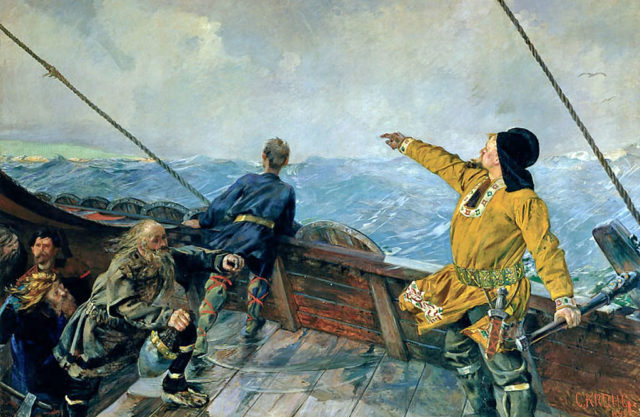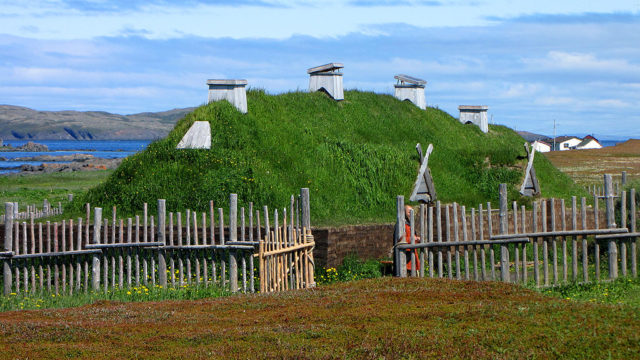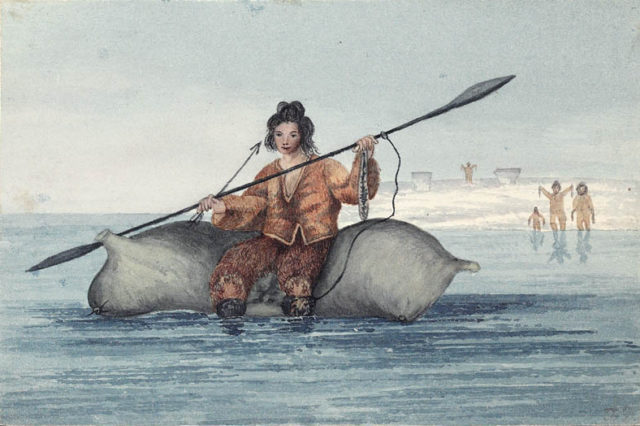Despite common belief, Christopher Columbus was not the first European to discover the Americas. A Viking known as Leif (the lucky) Erikson started a small village in Newfoundland, Canada, about 500 years before Columbus arrived.

Even though the Erikson family came from Norway, they migrated westward as generations were exiled or banished for homicide and other crimes. In about 1,000 AD, Leif ended up in Canada and founded a colony there. Specialists concur that the Vikings only lasted ten years at Vinland, eventually leaving not because of the cold or lack of food, but because they were run off by the thousands of natives who lived in the area.
In 1961, a team of archaeologists led by Helge Ingstad and his spouse Anne Stine Ingstad found the remnants of an ancient Viking colony located on the northern tip of Newfoundland, which they called L’Anse aux Meadows. Sod longhouses created in the Viking style and Viking artifacts such as worked wood, iron boat rivets, a whetstone, bone pin, a soapstone spindle whorl, and a ringed pin were found at the location.
Vikings VS Proto-Inuit Tribes
Not much is known about the Proto Inuit tribes that lived in Newfoundland during Erikson’s attempted colonisation. Historians thought it was likely that the Thule or Dorset tribes controlled the coast in 1,000 AD.
The pieces of indigenous reports that remain currently show that the early Inuit were completely aware of the Norsemen and the danger they presented to their native lifestyle. The tales of the Inuit and Norse interactions were filled with bloodshed and violence, normally carried out in the name of vengeance.

The Sagas Account
Most of what we know about Erikson’s voyages and the Viking’s meeting with the natives comes from the Icelandic heroic tales, especially The Saga of the Greenlanders and, to a lesser extent, The Saga of Erik the Red.
The heroic tales mention how things did not go well for Leif’s colony in the New World. For instance, his brother Thorvald Erikson perished while searching the coastline south of the campground. Not long after arriving ashore, they met a band of natives, known by the Norsemen as the skraelings.
Thorvald’s warriors managed to defend their ships and retreat, but Thorvald was lethally struck by an arrow.
A line from The Saga of the Greenlanders:
“I have gotten a wound under the arm,” said he, “for an arrow fled between the edge of the ship and the shield, in under my arm, and here is the arrow, and it will prove a mortal wound to me. Now counsel I ye…bury me, and set up crosses at my head and feet, and call the place Krossaness forever in all time to come.”
Thorvald was the first European known to have been slain and buried on the American continent.
The youngest Erikson sibling, Thorsten, tried to recover the body of Thorvald, but he became ill and perished before his party could get to Vinland. His wife was relentless and directed another voyage to Newfoundland. She was known as Gurid Thorbjorns and, upon the passing of her spouse, she married Thorfinn Karlsefni Þórðarson. By the following spring, she had persuaded Karlsefni to go back to Vinland.

A Journey Through the Treacherous Mountains of Antarctica
They arrived at the Viking settlement and were delighted to discover the grapes and wheat that had been planted on the last expedition growing. The winter was very treacherous, yet the party’s dealings with the natives were at first mostly peaceful.
The End of the Vinland Settlement
Karlsefni forbade all of his men from trading spears or swords with the Inuit, but apart from that many goods were exchanged, largely of spun red cloth for pelts.
Things went south one day when a Norse bull broke loose of its confinement and charged right into the native’s camp. They were afraid, not being familiar with the bull, and they considered it an intentional attack created by the Norsemen.
Karlsefni was forced to retreat to a defended place. At that moment, the Norsemen realised that even though this was a good land, there would always be war and terror. They decided to move away.
Vinland was simply too far from the Viking strongholds of Iceland and Greenland. There were neither the resources or the manpower required to defend the location against the natives. After less than ten years the Vinland colony was abandoned. The Americas would not be colonised again by Europeans for around 500 years.
